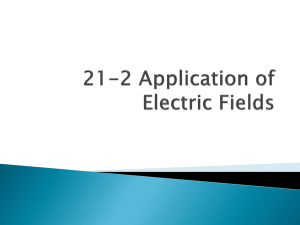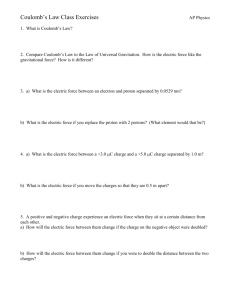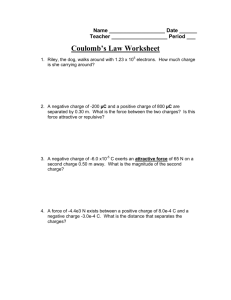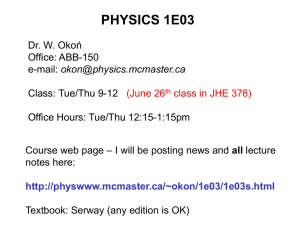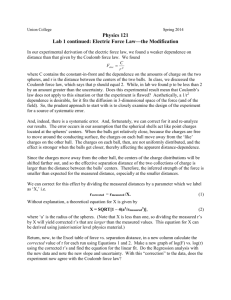Coulomb's Law - Mr. Gabrielse's Physics Class
advertisement
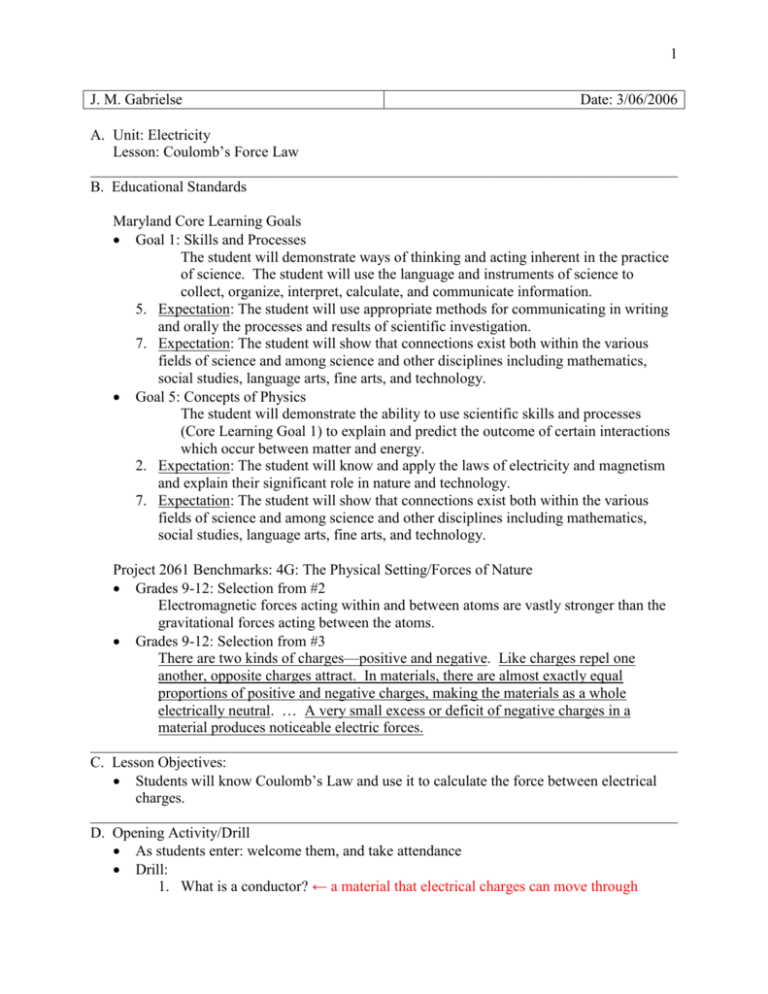
1 J. M. Gabrielse Date: 3/06/2006 A. Unit: Electricity Lesson: Coulomb’s Force Law ______________________________________________________________________________ B. Educational Standards Maryland Core Learning Goals Goal 1: Skills and Processes The student will demonstrate ways of thinking and acting inherent in the practice of science. The student will use the language and instruments of science to collect, organize, interpret, calculate, and communicate information. 5. Expectation: The student will use appropriate methods for communicating in writing and orally the processes and results of scientific investigation. 7. Expectation: The student will show that connections exist both within the various fields of science and among science and other disciplines including mathematics, social studies, language arts, fine arts, and technology. Goal 5: Concepts of Physics The student will demonstrate the ability to use scientific skills and processes (Core Learning Goal 1) to explain and predict the outcome of certain interactions which occur between matter and energy. 2. Expectation: The student will know and apply the laws of electricity and magnetism and explain their significant role in nature and technology. 7. Expectation: The student will show that connections exist both within the various fields of science and among science and other disciplines including mathematics, social studies, language arts, fine arts, and technology. Project 2061 Benchmarks: 4G: The Physical Setting/Forces of Nature Grades 9-12: Selection from #2 Electromagnetic forces acting within and between atoms are vastly stronger than the gravitational forces acting between the atoms. Grades 9-12: Selection from #3 There are two kinds of charges—positive and negative. Like charges repel one another, opposite charges attract. In materials, there are almost exactly equal proportions of positive and negative charges, making the materials as a whole electrically neutral. … A very small excess or deficit of negative charges in a material produces noticeable electric forces. ______________________________________________________________________________ C. Lesson Objectives: Students will know Coulomb’s Law and use it to calculate the force between electrical charges. ______________________________________________________________________________ D. Opening Activity/Drill As students enter: welcome them, and take attendance Drill: 1. What is a conductor? ← a material that electrical charges can move through 2 2. What is an insulator? ← a material that electrical charges can’t move through 3. What are the two charging methods? ← charging by conduction: touching & charging by induction: separating the charges Go over the drill. Modifications: The drill we be on the board and read orally. ______________________________________________________________________________ E. Development Immediate Feedback: Static Electricity Engagement of Students o Use balloons and the Van de Graaff generator to answer these questions. o Students may propose experiments. o Is the force between charges: Directly or inversely proportional to how big the charge is. Directly or inversely proportional to how far apart the charges are. Modifications: Extra time provided to students who require it ______________________________________________________________________________ Exploration Activities o We have two charges, call them A and B. Draw A and B on the board. o One has charge qA and the other has charge qB. o Try to discover the equation for the force between them. Play with balloons. Are force and charge directly or inversely proportional? Well, if there is more charge does the force get bigger or smaller? Are force and distance directly or inversely proportional? Well, if the distance gets bigger does the force get bigger or smaller? Modifications: The teacher will demonstrate what is expected in addition to the written instructions. Students will be paired with another student that can read. Extra processing time will be allotted. ______________________________________________________________________________ Explanation: o Notes: Electricity 3. Coulomb’s Force Law a. The unit of electric charge is the coulomb (C) i. 1 electron has a charge of -1.60 x 10-19 C ii. 6.25 x 1018 electrons = 1 C q q b. F K A 2 B d i. F is the magnitude of the force between charge A (qA) and charge B (qB) 3 ii. d is the distance between qA and qB 2 iii. K = 9.0 x 109 NCm2 Modifications: Classmate and teacher assistance available. The notes will be projected on the board and reviewed orally. Extra processing time will be allowed for students who require it. ______________________________________________________________________________ Extension o Example (p. 474): Coulomb’s Law Two charges are separated by 3.0 cm. Object A has a charge of + 6.0 C, while object B has a charge of +3.0 C. What is the force on object A? D = 3.0 cm (1 m/100cm) = 0.03 m qA = (+ 6.0 C)(1 x 10-6 C/1 C) = 6 x 10-6 C qB = (+ 3.0 C)(1 x 10-6 C/1 C) = 3 x 10-6 C q q 2 F K A 2 B = (9.0 x 109 NCm2 )(6 x 10-6 C)( 3 x 10-6 C)/( 0.03 m)2 = d 180 N away from object B o Chapter 20 Practice Problems (p. 476): 1, 3 o Chapter 20 Review (p. 478): 20 Modifications: Students who need extra time will be allowed it. Teacher assistance is available as time permits during class. The notes are also available every day after school. Modifications will be made to the worksheet according to individual need. ______________________________________________________________________________ Evaluation/Assessment o The homework will be graded. Modifications: Teacher assistance is available as time permits during class and after school. The notes are also available every day after school. Modifications will be made to the worksheet according to individual need. ______________________________________________________________________________ F. Closure What happens to the force between two charges if one of the charges gets bigger? What happens to the force between two charges when they are brought closer together? Modifications: Extra think time will be allowed for processing ______________________________________________________________________________ G. Home Assignment Read p. 481-487 Chapter 20 Review (p. 478): 20, 24 (hint the charge on an electron is on p. 472), 25, 26 4 Electricity Notes (Continued): 3. Coulomb’s Force Law a. The unit of electric charge is the coulomb (C) i. 1 electron has a charge of 1.60 x 10-19 C ii. 6.25 x 1018 electrons = 1 C q Aq B F K b. d2 , i. F is the magnitude of the force between charge A (qA) and charge B (qB) ii. d is the distance between qA and qB iii. K = 9.0 x N m2 109 C2

